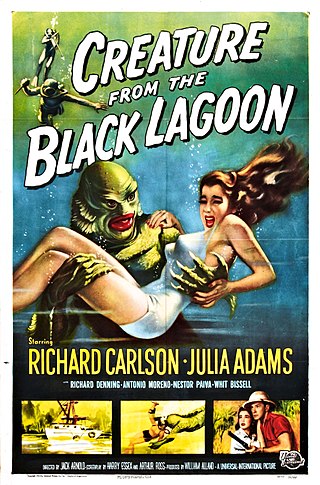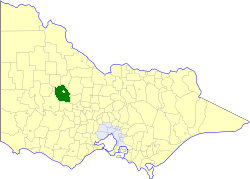
Creature from the Black Lagoon is a 1954 American black-and-white 3D monster horror film produced by William Alland and directed by Jack Arnold, from a screenplay by Harry Essex and Arthur Ross and a story by Maurice Zimm. It stars Richard Carlson, Julia Adams, Richard Denning, Antonio Moreno, Nestor Paiva, and Whit Bissell. The film's plot follows a group of scientists who encounter a piscine amphibious humanoid in the waters of the Amazon; the Creature, also known as the Gill-man, was played by Ben Chapman on land and by Ricou Browning underwater. Produced and distributed by Universal-International, Creature from the Black Lagoon premiered in Detroit on February 12, 1954, and was released on a regional basis, opening on various dates.

St Leonards is a coastal township near Geelong, Victoria, Australia, at the eastern end of the Bellarine Peninsula and the northern end of Swan Bay. Situated 33 kilometres (21 mi) east of Geelong, St Leonards was a filming location for the Australian television series SeaChange.

The Cornhill Magazine (1860–1975) was a monthly Victorian magazine and literary journal named after the street address of the founding publisher Smith, Elder & Co. at 65 Cornhill in London. In the 1860s, under the editorship of William Makepeace Thackeray, the paper's large circulation peaked around 110,000. Due to emerging competitors, circulation fell to 20,000 by 1870. The following year, Leslie Stephen took over as editor. When Stephen left in 1882, circulation had further fallen to 12,000. The Cornhill was purchased by John Murray in 1912, and continued to publish issues until 1975.

St Leonard's College is an independent co-educational school in Melbourne, Australia. Located in Brighton East, the school caters for students in all year levels from ELC for three-year-olds to Year 12.

Cocos Lagoon appears as a small incomplete coral atoll attached to the south-western coast of Guam near the area of the village of Merizo. It stretches about 5.5 km (3.4 mi) east-west and 3.5 km (2.2 mi) north-south, covering an area of more than 10 km2 (3.9 sq mi).

The Shire of Kara Kara was a local government area about 240 kilometres (149 mi) northwest of Melbourne, the state capital of Victoria, Australia. The shire covered an area of 2,292.79 square kilometres (885.3 sq mi), and existed from 1861 until 1995.
Kokkilai lagoon is an estuarine lagoon in Mullaitivu District and Trincomalee District, north-east Sri Lanka. The town of Kokkilai is located on a sand bar between the lagoon and the Indian Ocean.
Uppu Aru lagoon is a lagoon in Jaffna District, northern Sri Lanka. The lagoon separates the Valikamam region from the Thenmarachchi region.
Vadamarachchi lagoon is a lagoon in Jaffna District, northern Sri Lanka. The lagoon is sometimes referred to as Thondamannar lagoon. The lagoon separates the Vadamarachchi region from the Valikamam and Thenmarachchi regions.

Chundikkulam Lagoon is a lagoon in Jaffna District and Kilinochchi District, north-east Sri Lanka. The town of Chundikkulam is located on a narrow piece of land between the lagoon and the Indian Ocean. The lagoon is sometimes referred to as Elephant Pass Lagoon.
Chalai Lagoon is a lagoon in Mullaitivu District, north-east Sri Lanka. The town of Chalai is located on a sand bar between the lagoon and the Indian Ocean.
Nai Aru Lagoon is an estuarine lagoon in Mullaitivu District, north-east Sri Lanka.
Ullackalie Lagoon is a lagoon in Trincomalee District, eastern Sri Lanka.
Upaar Lagoon is an estuarine lagoon in Batticaloa District, eastern Sri Lanka.

Batticaloa Lagoon is a very large estuarine lagoon in Batticaloa District, eastern Sri Lanka. The city of Batticaloa is located on land between the lagoon and the Indian Ocean.Batticaloa district is flourished with three lagoons, such Batticaloa lagoon, Valaichchenai Lagoon and Vakari Lagoon. Among them, Batticaloa lagoon is the largest lagoon in Batticaloa District. Batticaloa lagoon is a long and narrow lagoon situated in the east coast of Sri Lanka with the total area of approximately 11,500 ha of water.

Negombo Lagoon is a large estuarine lagoon in Negombo, south-west Sri Lanka.
Mundal Lagoon is a lagoon in Puttalam District, western Sri Lanka. The lagoon is sometimes referred to as Mundal Lake.

The Puttalam Lagoon is a large 327 km2 (126 sq mi) lagoon in the Puttalam District, western Sri Lanka.

St. Leonard of Port Maurice, or more simply St. Leonard's, is a parish of the Roman Catholic Church in the Archdiocese of Boston. It is noted for its historic parish church located at the corner of Hanover and Prince Streets in the North End of Boston, one of the oldest churches built by Italian immigrants in the United States. The church is a pending Boston Landmark.

St Leonards Park is a heritage-listed bowling club, 15-hectare (37-acre) urban park, rugby field and cricket oval at 283a Miller Street, North Sydney, North Sydney Council, New South Wales, Australia. It was designed by William Tunks, Mayor and built during 1838. It was added to the New South Wales State Heritage Register on 31 July 2015.













